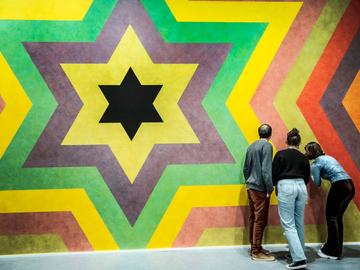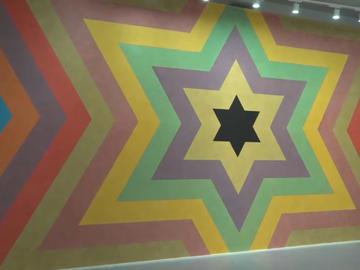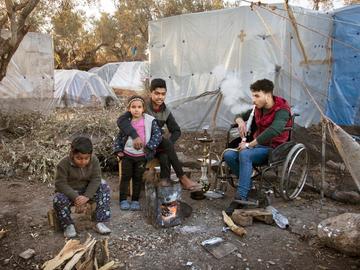At the Jewish Museum of Belgium, an exceptional exhibition examines two rarely explored aspects of the American conceptual artist Sol LeWitt's work. It also presents four key frescos that were created in situ by students from three art schools in Brussels.
© Saskia Vanderstichele
In July 1972, Galerie MTL in Brussels presented Sol LeWitt's first exhibition in Belgium. Among other works, the American conceptual artist presented Wall Drawing #138 for the first time, a fresco that he produced in situ with the assistance of Luc Verbeek, Lili Dujourie, and others. The piece in pencil, which contained 59 arcs, circles, and grids that created intriguing optical effects, was made by following very strict protocols, which included the materials to be used and the dimensions of the space and of the wall.
What was special about the works in this highly structured series was that their lifespan was tied to that of the exhibition, at the end of which they were destroyed. Following those same protocols, nearly 50 years later, Wall Drawing #138 has been recreated on a wall in one of the exhibition rooms of the Jewish Museum of Belgium. With completely different results. This drawing, along with three other Wall Drawings, works on paper, and sculptures make up “Sol LeWitt. Wall Drawings, works on paper, structures (1968-2002)”, a thematic exhibition which explores two distinct aspects of Sol LeWitt's work: his ties to his Jewish heritage and the close relationships that the artist was able to develop throughout his career with collectors, gallerists, and artists based in Belgium.
DIFFERENT PERIODS
Between 1968 and 2007, Sol LeWitt produced 1,270 Wall Drawings. In the beginning, the artist was directly involved in their production, but he very quickly entrusted that task to assistants, supervised by specialists. The production process defined the piece as much as the final result. The four frescos in this Brussels exhibition were selected in collaboration with the Sol LeWitt Foundation and Yale University, who oversaw the production of the Wall Drawings. They demonstrate different periods and offer an insight into the evolution of the artist's work and research relating to it. Wall Drawing #368, which takes up three walls in the large room on the ground floor is like the entrance to the work. The horizontal, vertical, and diagonal stripes, in black and white and in the primary colours, yellow, red, and blue, create an immersive optical effect as you progress further into the room. The piece is one with the space and volume. The unique tonality of the colours, saturated though they are, is due to the fact that they were not applied with a paint brush but by stamp with acrylic paint diluted with water. The artist began to develop this technique following a stay in Tuscany in the late 1970s where he encountered frescos of the quattrocento.
At first, it didn’t look like anything; just some lines drawn on walls. But once it was finished, I was stunned
On the next floor up, Wall Drawing #780 occupies an entire wall. At the centre of the composition is a six-pointed star, unmistakably evocative of the star of David. Unlike the piece on the ground floor, the pastel-tinted colours are the result of a mix of colours applied by stamp in a very precise order, in very precise quantities, and with an exact drying time. In the corridor, there is another fresco in colour, a study of the form of the cube. The impressive but understated Wall Drawing #138 can only be fully appreciated when viewed up close so you can see the perfectly interlacing arcs and circles, which were drawn in pencil with a compass that was made to measure according to the dimensions of the piece.
UNIQUE CONNECTIONS
The Sol LeWitt exhibition is unprecedented. It was put together by the Jewish Museum of Belgium in collaboration with the artist's estate. It explores themes that have rarely been investigated until now. Born into a family of Jewish immigrants from Russia, the artist, described by his wife as a “very, very observant non-believer”, was always discreet about such matters. Towards the end of his life, however, he was actively involved in his community in Chester in Connecticut, where he designed (in collaboration with the architect Stephen L. Lloyd) the new synagogue of the reformed Congregation Beth Shalom Rodfe Zedek. For him, designing a synagogue posed “the challenge of geometric forms in a space that must conform to ritual purposes.”
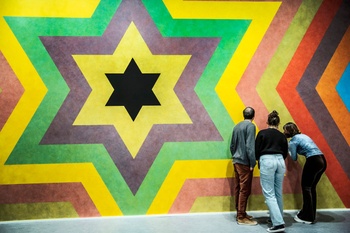
© Saskia Vanderstichele
| At the centre of the composition of 'Wall Drawing #780' is a six-pointed star, unmistakably evocative of the star of David. “In the beginning, it didn’t look like anything, just some lines drawn on some walls.”
The exhibition also touches on his relationship with the art scene in Belgium. “He developed strong and unique connections there!" says Laia Lozano, project manager at the Jewish Museum. "Although, in the 1970s, his work had already been exhibited in Düsseldorf at the Konrad Fischer Galerie, Sol LeWitt was one of the first conceptual artists to be exhibited in Belgium, thanks to the work of the Galerie MTL in Brussels. He came here four times, between 1974 and 1975, and remained very active in the Brussels art scene and in Liège, where he collaborated with Charles Vandenhove on the CHU project.”
RESPECT THE PROTOCOLS
Fourteen students from three art schools in Brussels worked for three weeks to create the frescos. They were supervised by the two professionals provided by the Sol LeWitt Foundation: the US artist Andrew Albert and the Belgian artist Remi Verstraete. Just after graduating, the latter collaborated as an assistant at the Sol LeWitt exhibition at the M Museum in Leuven in 2012 before working as a professional assistant for the Sol LeWitt Foundation on exhibitions in France and Italy. “It's enthralling and demanding work,” he says. “You have to be very precise and respect the protocols set out by the artist, but artistic decisions must also frequently be made, depending on the location, and you have to be able to keep the balance between the two.”
Francesco Battistello, a second-year painting student at La Cambre, volunteered because he was looking for an experience that would draw him out of his normal modes of practice. “I didn't know Sol LeWitt's work very well. My way of painting is much freer and more figurative. I felt that I had a lot to learn from it from a technical point of view.”
When I first saw the images, I could never have imagined all the calculations that would be involved
Charlotte Perin, a third-year Liberal Arts student at LUCA School of Arts – Campus Sint-Lukas, was drawn to the collaborative aspect of the work. “It was a really enriching apprenticeship and skills sharing experience. We began by spending a week taking measurements. I found it very interesting. When I first saw the images, I could never have imagined all the calculations that would be involved.”
Asia Gelin, a third-year painting student at the Académie Royale des Beaux-Arts de Bruxelles volunteered to work on the frescos. “I know Sol LeWitt's work, and I had seen some of his Wall Drawings. In my own work, I do a lot of experimenting and I found it very interesting to work with a very clearly-defined structure.”
The experts directed the students like a team on a construction site. Some of them were allocated a specific type of work, while others spent nearly all their time on the same Wall Drawings.
Francesco worked mainly on Wall Drawing #780. “To start with, I worked for a week taking measurements and drawing lines. When it came to applying the colours, I discovered the stamp technique and colour mixing, which was completely new to me. You have to be careful, like when you are following a recipe.”
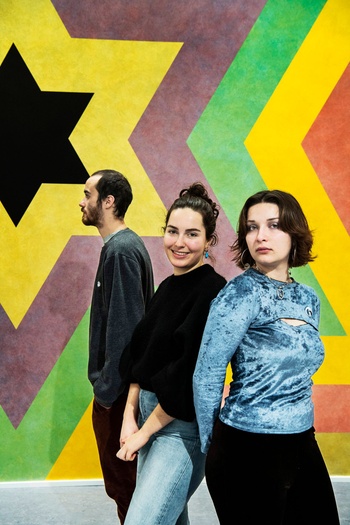
© Saskia Vanderstichele
| Francesco Battistello, Asia Gelin, Charlotte Perin and eleven other students from three art schools in Brussels worked for three weeks to create Sol LeWitt’s frescos.
Charlotte spent most of her time on the pencil fresco. “It was fascinating but very strange. I could not touch the wall, only Andrew was permitted to do so. I spent nearly six days sharpening pencils to keep mine the right size and maintain a continuous line. I also frequently had to adjust the compass to the dimensions of the arcs. When Andrew finally became tired of drawing, I was able to hold the compass and the pencil.”
Based on the four Wall Drawings that were chosen and the dimensions of the rooms in which they would be produced, the Sol LeWitt Foundation drew up a complete list of all the material needed, the quantity of tape, string, and pencils; it was extremely precise. Asia began in the ground-floor room where she marked out the space. “Before the lines were even drawn on the walls, reference points had to be marked. I put tape everywhere and we spent a long time scotch-taping the white parts.”
DIFFERENT EVERY TIME
At the end of the experience, the students returned to their own work. At this stage, it is too early for them to evaluate the lasting impact of this immersion into the world of the American conceptual artist.
The moment you remove the tape and discover the finished piece is always a surprise
“I enjoyed engaging in a very structured creative process,” says Asia. “I think I will reflect on whether that aspect could bring something to my work. I also liked the collective aspect, open to everyone; that's not something that I was used to at school.” “I am very impulsive,” continues Charlotte. “When I begin a project, I never know how it will end. I am also very sensitive to colours. This way of mixing colours by applying them one by one was very new to me. Because I never predict anything, the future is like a blank canvas. So, you never know what it might lead to.”
Out of the entire structured process, Francesco will remember the unveiling above all. “In the beginning, it didn't look like anything; just some lines drawn on some walls. But once it was finished, I was stunned by what it had become. I am very pleased with what I have done.” “Even though you think you know the drawing as a result of the process, the moment you remove the tape and discover the finished piece is always a surprise because it's different every time,” says Remi Verstraete.
SOL LEWITT. WALL DRAWINGS, WORKS ON PAPER, STRUCTURES (1968-2002)
3/12 > 1/5, Jewish Museum of Belgium, www.mjb-jmb.org
Read more about: Expo , Sol LeWitt , Jewish Museum of Belgium
